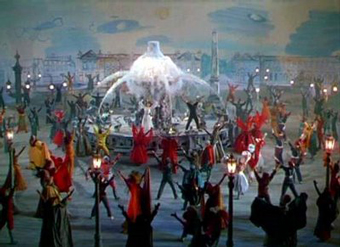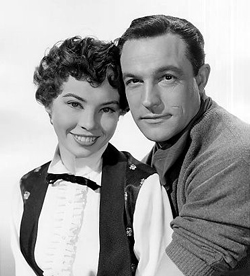
 |
|
|
|
If you've heard of An American in Paris you already know that it's one of the top musicals ever made and one of the artistic high points in the history of the MGM studio. In the production unit of Arthur Freed, MGM bankrolled a concentration of musical and dancing talent that no smaller organization could possibly have put together; it's one of the truly persuasive arguments in favor of the old studio system. Inspired by the music of George and Ira Gershwin, Freed put his most creative talent into this one entertainment. The ambitious Vincente Minnelli was a meticulous design-oriented director, while the energetic star and choreographer Gene Kelly was hooked on the idea of blending dance and cinema into new, unseen forms. The two collaborated with the remarkable cinematographer John Alton on an enormous 17-minute ballet. A recent arrival from the ranks of low budget film noir, even Alton had to stretch: the marathon music and dance number was his first work in Technicolor. Hollywood attempts at artistic achievement have often been met with indifference, even when they succeed. William Dieterle's cinematic wonder A Midsummer Night's Dream surely did honor to Shakespeare, but high-toned critics decried its cast of "lowly" film actors. Fantasia, Walt Disney attempt to combine serious classical music and animation, is still referred to as kitsch that demeans great musical art. Film historians point to the "cinematic" ballet in Michael Powell and Emeric Pressburger's The Red Shoes as an important precedent; many dance critics had little use for it as well. Hollywood films were expected to be escapism first and art "maybe"; Minnelli and Freed took a big risk with their consciously "arty" ballet finale. 
That America accepted and celebrated An American in Paris perhaps marks the highpoint of post-war optimism, a time just before the anxieties of those years claimed a big piece of the culture. Alan Jay Lerner's script is as simple as any of MGM's formula musicals. Ex- G.I. Jerry Mulligan (Gene Kelly) tries to become a painter in an idealized post-war Paris that still loves Americans. He lives in the same building as Adam Cook (Oscar Levant), a pianist-slacker who lives from fellowship to fellowship grant. Mulligan meets two women on the same day. Well-heeled Baltimore divorcée Milo Roberts (Nina Foch) offers to sponsor Jerry's art, but is really looking for a new man to keep. Jerry's eye instead goes to the young Parisian Lise Bouvier (Leslie Caron). He falls in love almost immediately. The problem is that Lise is engaged to successful singer Henri Baurel (Georges Guétary), a close associate of Adam. Jerry's Yankee sense of humor helps win Lise's heart, but she feels too indebted to Henri to let him down. A strong story is often irrelevant to a classic MGM musical; superior pictures like On the Town and The Band Wagon aren't much in the plot department either. The important factors are the music, the talent and the treatment of the musical numbers. Paris glides from one jubilant Gershwin winner to the next, none of which repeat a mood. Jerry, Adam and Henri celebrate friendship with "By Strauss", dancing with the fat barmaid and an ancient, but cheerful lady bystander. Jerry has fun playing with the neighborhood kids with the song "I Got Rhythm"; the kids seem genuinely amused. Georges Guétary belts out a flashy Follies Bergére- type song called "I'll Build a Stairway to Paradise", while the egotistical Adam daydreams of triumph as a concert pianist performing "Concerto in F for Piano and Orchestra". Jerry and Lise's key romantic tune is "Our Love is Here to Stay". Gene Kelly is Gene Kelly, aggressive when he's smiling and assertive when he sulks. We always like him but admire his talent more. The underrated Nina Foch pulls the short straw and takes the thankless role, yet never earns our scorn. We don't laugh as she beats a hasty exit at the conclusion. Oscar Levant for once plays a part similar to what he reportedly was in real life, a chain-smoking, resentful misanthrope. However, his powerful performance at the piano keyboard washes away all sins. Guétary is nowhere near as charismatic as Maurice Chevalier but can certainly belt out a song. We're surprised when Leslie Caron tells us that he wasn't very bright. As for Miss Caron, she's the magic extra ingredient for a legendary movie, a Parisian of enormous talent and charm, "discovered" just in time to provide Gene Kelly with one of his best dance partners. 
An American in Paris is a beloved title but not the popular favorite. Many fans appreciate its artistry but consider it cold. Most of the other top MGM musicals display a broader streak of comedy, and the supposed 'best musical of all time' Singin' in the Rain is wittier, more complex and even has relevance as an account of Hollywood history. Oscar Levant's forced cynicism plays against the mood, as the show never makes a full statement about artistic vagabonds. The sentiment and heart in Paris is really a fusion between the personalities and the music. Caron's perky smile and laugh are winning but she seems truly heartbroken only when backed by Gershwin. It's less a variety musical than a romantic fusion. Kelly's performance in the big "An American in Paris Ballet" integrates dance and music so closely together that he seems to personify the spirit of Gershwin. Busby Berkeley and to some extent Michael Powell's big dance extravaganzas made the camera an active participant in the flow of music and dance, but Kelly's choreography unites music, dance camera and performance into a seemingly living entity. Add to that John Alton's intense color lighting (with difficult, choreographed lighting changes) and the Ballet may be the most complicated dance ever put on film. It's an almost perfect collaboration. Vincente Minnelli's "Limehouse Blues" number in Ziegfeld Follies is certainly arresting, but it suffers from overworked ornamentation and garish special effects. Minnelli's spectacular design motifs here are in much better balance. The ballet progresses through a parade of classic painting styles that mimic artists like Utrillo, Renoir and Van Gogh. Perhaps the best compliment for the Ballet is that it does full justice to Gershwin. The music stands alone as a supremely emotional experience, and the Ballet only heightens it. There's none of the oddball mismatches of music and visuals that one remembers from certain segments in Fantasia. An American in Paris is "artsy" Hollywood filmmaking worthy of superlatives. Warners' Blu-ray of An American in Paris follows up on their two-disc special edition from last Fall. The added dimension of HD really makes a difference. The film was given an exacting (and I imagine extremely expensive) digital restoration; I only saw a shot or two where the color registration might even be questionable. The film looks good in the normal passages, with the expected high-key lighting and too-uniform skin tones that dominated Technicolor of the time. Daytime Parisian street scenes have the good kind of artificial back lot quality, as opposed to the strange indoor-Disneyland look of something like Brigadoon. The night scenes are even more impressive. A water-tank-and-painted-backdrop setting on the edge of the Seine that creates an astonishingly good illusion of reality; compare it to the brief daytime scene where Jerry Mulligan paints in a similar real location. But the magic of HD Blu-ray really takes off in the big Ballet number. Previous video iterations couldn't quite handle the bright reds, especially when John Alton bathes the dance on the fountain in primary hues. The wild colors hang together without bleeding or turning a sickly orange. The complex numbers have as many as 40 dancers on screen at any one time, and we can pick out costume details that aren't normally apparent. I hadn't even noticed that a couple of Leslie Caron's costume changes are disguised across clever cuts. In keeping with Warners' devotion to MGM musicals, An American in Paris is given a deluxe roster of extras. Most of the filmmakers have passed away, but archived interview bites are arranged on a commentary hosted by Patricia Ward Kelly: Kelly, Minnelli, Freed, Alan Jay Lerner, Johnny Green, Saul Chaplin, Michael Feinstein, Preston Ames and Irene Sharaff; new voices include Lesie Caron and Nina Foch. A very good long-form docu by Trailer Park (no names credited) tells the entire story of the making of the film, with choice photos and relevant film clips from other movies (HD). Fat audio-only galleries list song outtakes and radio promos. A restored Technicolor song outtake has Georges Guétary singing "Love Walked In". The single Blu-ray disc also contains the entire American Masters docu Gene Kelly: Anatomy of a Dancer reviewed by Savant in 2002, and the superb Tex Avery cartoon Symphony of Slang. Audio choices include tracks in French, Spanish (2 varieties), German and Italian, with subtitles in English, French, Spanish, Danish, Dutch, German, Italian, Norwegian and Portuguese.
On a scale of Excellent, Good, Fair, and Poor,
An American in Paris Blu-ray rates:
Reviews on the Savant main site have additional credits information and are often updated and annotated with reader input and graphics. Also, don't forget the 2009 Savant Wish List. T'was Ever Thus.
Review Staff | About DVD Talk | Newsletter Subscribe | Join DVD Talk Forum |
| ||||||||||||||||||